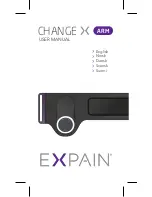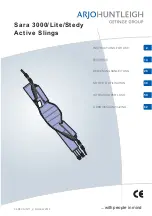
17
6. EXERCISE (some starters to get your pet on track)
•
Always check with your veterinarian to make sure your pet is healthy enough to start exercise on the
MiniPACER. If your pet has previous medical conditions such as heart/lung disease or orthopedic
issues, have a veterinarian examine your pet again before starting an exercise regimen.
•
Make sure your pet has gone to the bathroom before starting to exercise (We do not want accidents…)
•
Always start slow. Start out at a nice walking pace for about 5-10 minutes for the first couple of times,
and then slowly build up time by 2-minute increments to get your pet comfortable with the
MiniPACER. Once your pet can briskly walk for a full 20 minutes, progress your pet to a higher
speed with gradual increases of 0.5-1.0 MPH. Make sure to monitor how your pet tolerates exercise.
If your pet starts to show signs of exhaust or distress, slow down the speed and/or let your pet take a
rest.
•
Start with a steady walk for at least 5 minutes before going into a more vigorous workout.
•
Be consistent and committed. Your pet should receive daily activity, not just on the weekend!
•
Age and breed will factor in how much exercise your pet needs. Smaller and older dogs may not need
as long of walks as a 3 year old Labrador, but you and your veterinarian will be better able to judge
the appropriate amount of exercise your pet needs. Typically pets should receive approximately 30-40
minutes of exercise daily. Some pets will need two 30-minute increments of exercise on the
MiniPACER, split up during the day.
•
Always supervise your pet on the MiniPACER. Never leash a pet to the MiniPACER and walk away.
•
If your pet is overweight, always combine an exercise program with proper nutrition. Talk to your
veterinarian about guidelines for proper nutrition for weight loss.
•
Make sure your pet has plenty of water available before and after exercise.
•
Do not exercise puppies under 6 months for small breeds and larger breeds under 9 months for
extended periods of time. Excess stress on the joints can cause bone and cartilage development
problems later on in life. Puppies like to have activities in short bursts such as 5-minute increments,
not endurance activities.
•
Do not exercise your pet after a meal. Wait at least 1 hour after a meal before allowing them to go on
the MiniPACER. Full stomachs and high level of activity, especially in large deep-chested dog breeds
can cause bloat or twisted stomach, which are both emergencies.
•
If you have a short/flat muzzle dog, such as bulldogs, Shih Tzu’s, Pekingese, pugs, or short-legged
dogs such as dachshunds and basset hounds, do not be over zealous with activity.
Always watch for signs of exhaust or tiredness. If you see panting, slowing down/falling behind, stop
the treadmill and let your pet rest. Shorter, more frequent times of exercise are more beneficial.
•
Use of the MiniPACER is a great way to exercise your pet, but it is not a substitute for socialization
for your pet. Your pet should still have contact with other dogs and outdoor exercise when able.


































